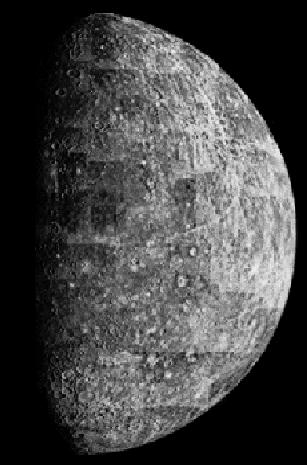Mercury (planet)
 From Citizendium - Reading time: 3 min
From Citizendium - Reading time: 3 min
Mercury at 0.4 AU (57,910,000 km) is the planet closest to our Sun, and it is the smallest of the eight planets in our solar system, with only a 0.055 Earth mass (3.30e23 kg) and a diameter of 4,880 km.

Parameters for classification as a planet[edit]
Mercury is classified as a planet by the International Astronomical Union for meeting the following criteria:[1]
- Orbits the sun;
- Has mass sufficient for its gravity to form a nearly round shape;
- Has mass sufficient for gravity to clear a path in its orbit.
Physical characteristics[edit]
Mercury has no natural satellites, and its only known geological features besides impact craters are "wrinkle ridges", probably produced by a period of contraction early in its history.[2] Mercury's almost negligible atmosphere consists of atoms blasted off its surface by the solar wind.[3] Its relatively large iron core and thin mantle have not yet been adequately explained. Hypotheses include that its outer layers were stripped off by a giant impact, and that it was prevented from fully accreting by the young Sun's energy.[4][5]
Rotational characteristics[edit]
Mercury’s surface temperature fluctuates from more than 400°C to -180°C . Planetary rotation means that alternating areas are exposed to the Sun’s heat, with the result that the surface of a planet will heat and cool in alternating periods. However, while Mercury does in fact rotate about its axis, Mercury’s rotational and orbital periods are coupled, that is, nearly the same. This means that some places on Mercury’s surface receive 2.5 times more solar radiation than other areas.[6] As the planet closest to the Sun it receives the highest ratio of solar radiation. Solar radiation decreases by the inverse square law as it reaches further away from the Sun. The Moon, by comparison, which also has no atmosphere but is much further from the Sun than Mercury, reaches temperatures of only about 110°C[7]
Orbital characteristics[edit]
Mercury's sidereal period is 87.97 days per year.[8] Mercury's distance from Sun is 0.31 AU at perihelion (the closest approach to the sun), 0.47 AU at aphelion (its most distant point) and it has an orbital inclination of 7.0° relative to the solar plane.[9]
References[edit]
- ↑ Honey, I Shrunk the Solar System NASA. “The International Astronomical Union has decided that, to be called a planet, an object must have three traits. It must orbit the sun, be massive enough that its own gravity pulls it into a nearly round shape, and be dominant enough to clear away objects in its neighborhood.”
- ↑ Schenk P., Melosh H.J. (1994), Lobate Thrust Scarps and the Thickness of Mercury's Lithosphere, Abstracts of the 25th Lunar and Planetary Science Conference, 1994LPI....25.1203S
- ↑ Bill Arnett (2006). Mercury. The Nine Planets. Retrieved on 2006-09-14.
- ↑ Benz, W., Slattery, W. L., Cameron, A. G. W. (1988), Collisional stripping of Mercury's mantle, Icarus, v. 74, p. 516-528.
- ↑ Cameron, A. G. W. (1985), The partial volatilization of Mercury, Icarus, v. 64, p. 285-294.
- ↑ The effect of rotation National Maritime Museum
- ↑ What happens to the Sun's radiation when it reaches a planet?NMM
- ↑ A sidereal period is the time it takes a planet to return to an orbital position relative to the stars
- ↑ The orbits of the planets National Maritime Museum
 KSF
KSF